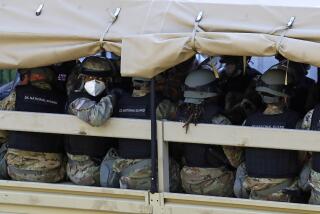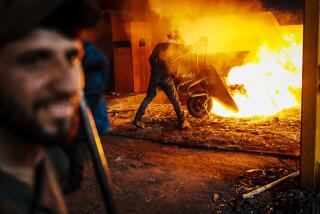Why Afghan ‘surge’ isn’t in the works
- Share via
WASHINGTON — In a sign that the U.S. military is scaling back its goals in Afghanistan, senior Pentagon officials are weighing controversial proposals to send additional teams of highly trained special operations forces to narrowly target the most violent insurgent bands in the country.
The proposals are part of an acknowledgment among senior brass that a large-scale influx of conventional forces is unlikely in the near future because of troop commitments in Iraq. It also reflects the urgency to take some action to reverse recent setbacks in Afghanistan.
The idea of sending more special forces has intensified the debate over the best way to fight the war in Afghanistan. As security worsens in the country, many military leaders are increasingly arguing that an Iraq-style troop “surge” and counterinsurgency plan would not work because of the country’s rugged geography and a history of resistance to rule from Kabul.
Unlike Iraq, where large portions of the population are urbanized in the wide, flat plains of the Tigris and Euphrates river valleys, much of Afghanistan is mountainous and dotted with remote villages that are hard to reach with large bodies of conventional forces, several Pentagon officials involved in the Afghanistan strategy review said.
“It’s a much different place, and to surge forces doesn’t necessarily fit,” said a senior military official involved in the discussions.
“This is one of Gen. [David H.] Petraeus’ greatest challenges,” he added, referring to the incoming commander of U.S. forces in the Middle East and Central Asia.
Three separate high-level reviews are underway on U.S. strategy in Afghanistan, where American forces have seen their highest death rate since the war began in 2001. According to military officials, the proposal for more special operations teams is being discussed in both the White House’s review and one led by Navy Adm. Michael G. Mullen, chairman of the Joint Chiefs of Staff.
Advocates of a plan focused on special operations argue that the top U.S. priority in Afghanistan should be preventing the country from again becoming a terrorist haven, an objective that could best be met by targeted attacks on militants in regions near the border with Pakistan.
In addition, the Army’s Green Berets are the U.S. military’s premier unit for training foreign security forces, making them ideally suited for linking up with the small but increasingly competent Afghan army to improve its ability to secure the country.
But critics in the Pentagon say the special operations approach would repeat many of the mistakes of Iraq; although the units could attack insurgents in trouble spots, they would not be able to hold ground to keep extremists from coming back.
Other military officials note that only 12 of the 36 special operations units already in Afghanistan are being fully used. Many lack the supporting infrastructure -- surveillance drones, helicopter transport and intelligence networks -- in part because it is still needed in Iraq.
“To add more forces on top of existing forces that haven’t been fully engaged makes no sense,” the senior military official said. “If you don’t know how you’re operating the current force, why do you think adding more forces is going to work?”
According to a senior Pentagon official, among those advocating a special operations influx is Army Lt. Gen. Douglas E. Lute, the White House’s Iraq and Afghanistan “war czar.” A spokesperson for Lute did not respond to requests for comment.
Both presidential candidates, Republican John McCain and Democrat Barack Obama, have advocated an increase in conventional forces for Afghanistan. The issue of special operations force levels has not been widely discussed in the campaign.
A move to a strategy focusing heavily on special operations would be a significant shift for the U.S. military. The current strategy, which is supported by 32,000 U.S. forces and 30,000 North Atlantic Treaty Organization troops from other nations, aims to stabilize and secure the country and foster a viable central government.
But some military planners doubt that Afghanistan is capable of the progress that Iraq has achieved. “Are we really going to take a Karzai government and prop it up?” asked another senior military official, referring to Afghan President Hamid Karzai. “If you’re talking about doing that, I can’t see this ever ending.”
Although the Iraqi government has frequently proved corrupt and ineffectual, the population is well-educated and skilled, providing abundant human capital once security can be achieved. In addition, Iraq’s oil industry and fertile agricultural sector have quickly ramped up since violence declined after nearly 30,000 additional U.S. troops arrived in 2007, a buildup strategy that some have advocated for Afghanistan.
Afghanistan has high illiteracy rates and little economic activity, making an Iraq-style “clear, hold and build” strategy more difficult to execute. The Soviet Union failed to control the country in the 1980s with more than 100,000 soldiers, and some U.S. military officials fear Afghans could see large-scale troop increases as a repeat of that occupation.
Although President Bush has decided to redirect an Army brigade and Marine battalion from Iraq to Afghanistan by January, any further troop reductions in Iraq could be slowed by commanders’ concerns over the need to maintain security during Iraqi elections scheduled next year.
Army Gen. David D. McKiernan, the overall commander in Afghanistan, has requested an additional three brigades and a division headquarters unit. Although there is widespread support for the increase within the Pentagon, it remains unclear when those troops will be made available.
“I don’t think anybody thought it was an unreasonable request, especially when you take into consideration the environment has changed,” the military official said. “I don’t think anybody is saying no more forces. I think people are saying ODA, or special forces, versus conventional forces,” the official said, using the initials of the Army’s Operational Detachment Alpha teams.
--
More to Read
Sign up for Essential California
The most important California stories and recommendations in your inbox every morning.
You may occasionally receive promotional content from the Los Angeles Times.










